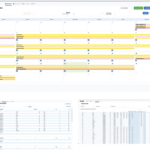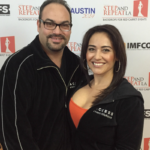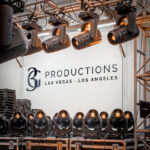The concept of the pop-up store – the temporary outlet that creates as much buzz as sales – has quickly become rooted in American retail strategy. Wybron CEO Keny Whitright has taken that one step further with his drive-by shop: Wybron's Mobile Light Lab, a 45-foot trailer that's high-tech on the inside and highly graphic on the outside. Tugged by a powerful Kenworth semi truck, the MLL made its debut in early February at Wybron's Colorado Springs headquarters and manufacturing center and marks a new chapter for the company, using this second iteration of taking its message and products on the road as a plan for the future. It was 4°F. the day before the truck was officially unveiled, but it was plenty warm inside the spacious Expando trailer rig. A small concierge foyer at the rear of the trailer greets visitors with a preview of the program on a 46-inch Samsung LCD. A second helps record their contact info entered via a Bluetooth keyboard. Inside, there are three more LCDs on each of the two side walls, connected to a corresponding Apple TV wireless router and next to product podiums representing the key Wybron product lines: the Cygnus advanced LED lights; Colorform IT, CX IT and Forerunner color changers; Nexera LX luminaires; Eclipse IT shutter and iris dowsers; the Transition fiber illuminator; and the Autopilot II 3D tracking systems for automated follow spots. Each device is controlled by an Apple iPad running Synthe FX's Luminair app, offering even more granular control of the systems than a typical lighting board would. At pre-set intervals during the MLL's stay in each market, what are the most comfortable folding chairs ever created are laid out in a fan configuration, and a Barco projector illuminates the trailer's front wall screen with two Wybron-produced videos.
Focus on Education
The first has celebrated lighting designer, Richard Pilbrow, talking documentary-style about his career in theatrical lighting for 10 engrossing minutes, stressing the art's fundamentals; the second is a brief parade of noted LDs including Michael O'Connor, Dawn Chiang and Ken Billington and production designer Michael Magg discussing particular challenges that designers face today.
What's refreshing about both productions is that neither mentions Wybron products. There's no hard sell here, though the fact that you're surrounded by them on the pedestals lining the truck reinforce the intended message that whatever challenges the LDs are enumerating, Wybron has a product to meet it. That kind of sophisticated communication between company and customer is part of a marketing strategy that Whitright hopes will double the company's sales this year. Wybron is ramping up to meet that expectation: its workforce is back up to 35 after nearly half of the company's employees were laid off during the recession.
New management for its 50,000-square-foot factory is working to consolidate and streamline processes and increase ROI, something that Whitright began over a decade ago when he started bringing in large, automated industrial systems, like an Amada punch press, a Daewoo coating line and an IPE lathe to consolidate in-house manufacturing, produce more customization of products and act as an adjunct to in-house R&D. The lathe, for instance, was purchased from the company that once did the millwork for Wybron at half the cost that subbing the work out had cost the lighting systems maker. Having that capability internally allows Wybron's engineers to experiment with incremental variations on mechanisms to refine the operation and functionality, with input on those changes' effectiveness coming immediately, "instead of a 40-mile feedback loop we used to have" with the third-party supplier, says Whitright.
Pulling out of a recession that hit the lighting and related industries hard is foremost on Whitright's mind. He founded the company 32 years ago and took a brief semi-retirement as the company's chairman in 2007, returning at last in mid-2008 from what he called "an extended fishing trip" to revitalize the product innovation that began with Wybron's Coloram color changer, which became a huge hit in theatrical lighting. Whitright estimates that Wybron was making as many as 10,000 color changers a year and has sold well over 100,000 since it began making them. Its Autopilot automated tracking system for followspots set a new bar for that technology, and in 1989, Whitright oversaw the addition of a gelstring service, ColorExpress, that substantially increased the volume of custom gelstring production.
Shifting to LEDs
Wybron has been the victim of its own success in some ways. Whitright acknowledges that the robustness of the color changers has meant that many that were bought decades ago are still in use, which has almost certainly cut into new-product sales. And at a time when even industrial products are under price pressure from overseas manufacturers and increased domestic competition, Whitright has tenaciously refused to compete on price, keeping his systems out of the reach of many regional and collegiate theater operations. He also takes responsibility for keeping Wybron out of the LED sector until recently, with the introduction, in 2009, of the Cygnus wash light line.
"I resisted getting into LED 10 years ago, because the color at the time was crap," says Whitright, with typical forthrightness. "You could use it to light a white wall but not scenery. But it did interest the engineers here, fortunately."
But Whitright's philosophy has earned industry respect. "He may not have the cheapest price in the marketplace, but I know if I buy something from Keny it will work and there is support," comments Norman Wright, vice president of engineering at distributor Group One's lighting division.
And Wybron has managed to maintain what its sales director Dusty Hudgins estimates is a better than 40-percent share of the color changer market. Gelstrings, sales of which have been off by 35 to 40 percent in the last two years due to the recession, are not likely to come back, with colored LEDs reducing the need for gels.
But, says Hudgins, lighting remains a product-driven business, and the Cygnus has shown good sales since its introduction and is doing so in both theatrical and other markets, including the critical House of Worship market. The new Austin City Limits Live venue in Texas, which opened in February, is an example of how Wybron's new products and new emphasis on marketing are converging: ACL Live has installed 50 Cygnus units, and Wybron is thanked prominently in the broadcast's closing credit roll. The Kennedy Center in Washington, D.C. has already come back for a second round of Cygnus lights in addition to the 100 they already have installed, which Whitright says constitutes a major theatrical seal of approval for the product.
Whitright and his market research team have formulated a "map" of the lighting product industry, with the express purpose of looking for holes that they can develop into. He won't be specific about other new products in development, but he did say that outdoor lighting ideas are on the agenda.
"We haven't figured out the answers yet, and a lot of it is still going on gut feeling," he says. "Hell, it took a year and a half to get into LED. But when we do decide to do something, we do it right and do it for good."


